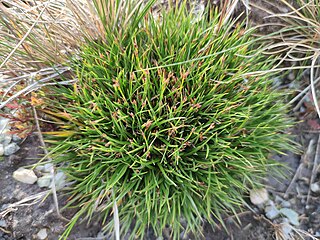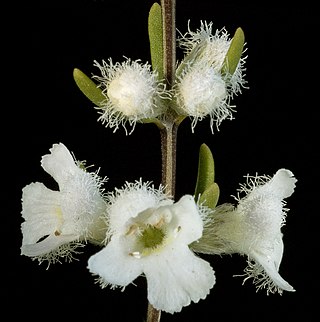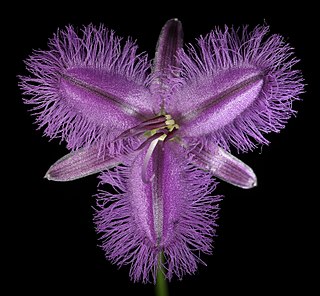
Spinifex longifolius, commonly known as beach spinifex, is a perennial grass that grows in sandy regions along the seacoast. It also lives in most deserts around Australia.

Schoenus brevifolius, known as zig-zag bog-rush, is a species of sedge native to Australia, New Zealand, New Caledonia, and the Ogasawara (Bonin) Islands. It was first described by Robert Brown in 1810.

Nymphoides geminata, commonly known as entire marshwort, is an aquatic plant of the family Menyanthaceae native to eastern Australia.

Oreobolus is a genus of flowering plants in the family Cyperaceae. The genus has a circumpacific distribution.
Anarthria scabra is an herbaceous plant found in Southwest Australia.

Alternanthera denticulata is a small prostrate white-flowering herb in the Amaranthaceae family. It is native to all states and territories of Australia, New Guinea, and the North Island of New Zealand. It is also one of the food plants of the varied eggfly, Hypolimnas bolina nerina.
Leptocarpus laxus is a rush species of the genus Leptocarpus in the family Restionaceae. It is endemic to the south-west of Western Australia.

Westringia rigida is a shrub in the Lamiaceae family that is endemic to Australia. and

Phlebocarya ciliata is a plant in the Haemodoraceae family, native to Western Australia.

Tremulina tremula is a plant in the Restionaceae family, found in the south-west of Western Australia.

Aristida ramosa is a species of grass that occurs in New South Wales, Victoria, Western Australia and Queensland. However, it is thought to have been introduced into Western Australia. It was first described by Robert Brown in 1810 who find it live at Port Jackson (Sydney). The species epithet, ramosa, is a Latin adjective meaning "branched" which describes the plant as bearing branches.
Alternanthera angustifolia is a small herb in family Amaranthaceae found widely in inland Australia from northern Western Australia, the Northern Territory, South Australia, New South Wales to Queensland.

Lechenaultia tubiflora, commonly known as heath leschenaultia, is a species of flowering plant in the family Goodeniaceae and is endemic to the south-west of Western Australia. It is a hemispherical subshrub or more or less erect perennial with crowded, narrow, rigid leaves and variably-coloured, tube-shaped flowers.

Microcorys barbata is a plant in the Lamiaceae family, native to Western Australia. It was first described by Robert Brown in 1810.
Perotis rara is a species of grass in the family, Poaceae, first described by Robert Brown in 1810. It is native to Australia, South-east China, Malaya, New Guinea, the Philippines, Taiwan, Thailand, and Vietnam.

Philydrella pygmaea is a plant species in the Philydraceae family, first described by Robert Brown in 1810 as Philydrum pygmaeum, and transferred to the genus, Philydrella in 1878 by Teodoro Caruel.
Polypogon tenellus is a species of annual grass in the family Poaceae, first described by Robert Brown in 1810. It is native to Western Australia and South Australia.

Thysanotus dichotomus is a herb in the Asparagaceae family, endemic to Western Australia, and first described in 1805 by Jacques Labillardière as Ornithogalum dichotomum. In 1810, Robert Brown transferred it to the genus, Thysanotus.

Schoenus pedicellatus is a species in family Cyperaceae, first described by Robert Brown in 1810 as Chaetospora pedicellata, but assigned to the genus, Schoenus, in 1811 by Jean Louis Marie Poiret. Note that GBIF and Plants of the World Online both give the genus change as being by Roem. & Schult. However the species is Australian and the text by Poiret is earlier than that of Roemer and Schultes.

Haemodorum laxum is a plant in the Haemodoraceae family, native to Western Australia, and was first described by Robert Brown in 1810.















